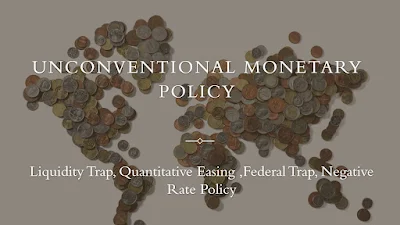What is Unconventional Monetary Policy:
According to RBI’s Deepak Mohanty, “When central banks look beyond their traditional instrument of policy interest rate, monetary policy takes an unconventional character.”
Sub-prime mortgage crisis:
The term is associated with sub-prime lending. Many US banks had lent money to sub-prime borrowers (those borrowers who were rated below the prime borrowers), and these sub-prime borrowers failed to pay back the loans they had taken during real estate boom time. When the bubble burst, banks lost most of their money. Big names Lehman Brothers collapsed and closed their operations, US went into a period of recession and it have an impact on the whole world. US Federal intervened and it tried everything it could do to prevent further collapse through Quantitative Easing.
Liquidity Trap :
Interest rates are very low / zero and saving rates are very high .
but
Public did not invest or spend the money (liquidity is trapped with people)
because of
the fear of adverse events like deflation, war.
↓
Monetary policy in the form of increase of money supply remains ineffective.
Situation in UK during 2009-14 was an example of Liquidity Trap in which Base interest rates were cut to 0.5% in March 2009.
Quantitative Easing (QE):
Background of QE:
In US, sub prime crisis
↓
Financial crisis of 2008
↓
situation of Liquidity Trap
↓
Zero Bound Rate ( a situation of interest rate being already very low). Federal Reserve is not able to stimulate economic growth by reducing the interest rate further.
↓
Quantitative Easing
QE is Expansionary monetary policy involving Open Market Operation (OMO) to deal with the negative impacts of Sub prime crisis and to stimulate the economy , bringing it back to the normal. In QE,FED purchased large quantities of Long term bonds from the market issued by government and private parties.It injected a large amount of liquidity in the economy prior to its scheduled time .It also increased the demand of Bonds ,raising their cost and further bringing down the interest rates in the Economy.
***************It is to be noted that the reduction in the rates in QE is not because of changes in REPO rates but because of Long term bonds .
Federal Tapering:
At the tail end of QE, FED gradually reduced monthly purchase of long term bonds. The process of gradual reduction in purchase of bonds is referred to as Federal tapering .Tapering resulting in less free money with banks and loans becoming costlier, inflation to go high.
IMPACT OF QE ON EMERGING MARKET ECONOMIES (EME):
Returns in emerging economies were higher so investors borrowed money in USA and invested it in markets of EME's .This process of moving capital from USA to EME 's is said to be CAPITAL FLIGHT. Capital flight made QE ineffective in USA to an extent and made inflows in EME'S.
Negative Rate Policy:
In case of this policy, banks charge you interest to keep cash with them, rather than paying you interest. The objective of this policy is to demotivate individual to park money with banks and to motivate him to invest in the market .
Negative interest rates regime might be seen during deflationary periods when people or institutions are inclined to hoard money rather than spend or lend it. Many European countries and Japan adopted this strategy during 2008 depression.
UNCONVENTIONAL MONETARY POICY IN INDIA:
Helicopter Money:
Money transfer from the central bank to the consumers without any liability of being paid back to the government .The concept is based upon the fact that this money when handed directly to consumers, motivates them to spend it immediately, boosting confidence in the economy. Telangana chief minister KC Rao advocated for this policy with the argument that helicopter money can help states comes out of this economic downturn because of Covid-19.
Incremental CRR(I-CRR): Huge liquidity during the demonetization 2016 /demonetization of 2000 Rs in 2023 led to financial instability and unique situation in the economy. I-CRR is an extraordinary tool to in which CRR is increased and the objective is to manage high liquidity in the economy.
LONG TERM REPO OPERATIONS (LTRO):
LTRO was adopted by RBI during covid-19.It is an unconventional measure in which RBI has given out loans for the period of 1-3 years at REPO rates. The objective is taken to inject extra liquidity into the banking system and boost credit growth. In the LTRO system, RBI believes that offering banks durable longer-term liquidity at the repo rate can help them lower the rates they charge on retail and industrial loans, while maintaining their margins.
Targeted Long Term Repo Operations (TLRTO): TLTRO is LTRO with certain modifications , the banks will have to invest the amount acquired as a loan under LTRO in specified securities like investment-grade corporate bonds, Commercial Papers, Non-Bank Financial Corporations (NBFCs) and Microfinance Institutions (MFIs).
Operation Twist’:
Operation Twist provides long term liquidity in the economy for investment purposes by inducing downward pressure on longer-term interest rates by lowering long-term Treasury yields.
RBI -------------------sale short-term securities-------------- funds available with RBI ---------------- buy long-term government debt papers------------Cheaper funds for long term.
Implications of Operation Twist:
- short loans costlier and hence controlling inflation in the short run.
- Lower longer-term yields help boost the economy by making loans less expensive for those looking to buy homes, purchase cars, and finance projects, while saving becomes less desirable because it doesn't pay as much interest.







